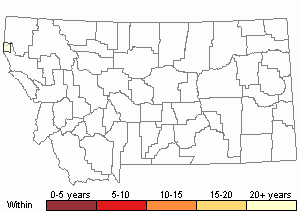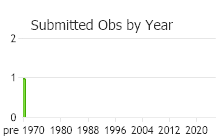View in other NatureServe Network Field Guides
NatureServe
Montana
Utah
Wyoming
Idaho
Wisconsin
British Columbia
South Carolina
Yukon
California
New York
Wavy Catharinea - Atrichum undulatum
Other Names:
Catherine's Moss
General Description
Plants: Acrocarpous (Vitt 1988). Growing in erect, open clumps, deep green (FNA 2007), becoming brown. Stems whitish from rhizoids below (Crum and Anderson et al. 1981), 20-50 mm (FNA 2007).
Leaves: Distant proximally on the stem and congested distally (FNA 2007), twisted and bent when dry, spreading widely when moist (Crum and Anderson et al. 1981), lance- to tongue-shaped, cupped to flat below with a dorsal ridge above, 4-9 mm in length, 0.8-1.5 mm in width, diagonally wavy, the ripples bearing teeth on the dorsal surface; apex narrowly pointed; costa extending to the end of the apex, its dorsal ridge toothed in the upper half, lamellate ventrally (FNA 2007); margins with single or double spiny teeth scattered from the base to the apex (Smith 1980).
Leaf Cells: Lamellae almost straight, smooth or nearly so (Crum and Anderson et al. 1981), 2-6, usually 2-7 cells high; lamina 1-layered except for the margin; medial laminal cells 6-sided to erratically angled, the angles sometimes softened with curves, occasionally longer crosswise, both dorsal and ventral surfaces rounded; walls moderate in thickness, the corners trigonous; papillae rough or forming delicate longitudinal ridges on the dorsal surface (FNA 2007).
Phenology
Fruit ripens from spring to mid-summer (July) (FNA 2007).
Diagnostic Characteristics
The strongly bowed and nearly level capsule along with its weedy environs are most helpful for identification (FNA 2007). Atrichum selwynii is often mistaken for this species in North America (Elliott 2016).
Range Comments
North American Range
This species has been recognized in the extreme Northeast (ME, NB, NL, NS, PE), also ON and BC (FNA 2007). Known in Montana from Cascade, Flathead, Glacier, Gallatin, Lake, Lincoln, Missoula, and Sanders Counties (Elliott 2016).
Observations in Montana Natural Heritage Program Database
Number of Observations: 1
(Click on the following maps and charts to see full sized version)
Map Help and Descriptions
Relative Density

Recency


 (Observations spanning multiple months or years are excluded from time charts)
(Observations spanning multiple months or years are excluded from time charts)
Habitat
Dry, disturbed soil in weedy areas, such as drainage furrows along roads. Mostly occurring at low elevations (FNA 2007).
Reproductive Characteristics
Polygamous, some shoots with both male and female structures (bisexual), and some apparently either male or female (FNA 2007); stems with terminal archegonia sometimes developing from the previous year’s antheridial head (Crum and Anderson et al. 1981). Perigonial bracts wide, individual plants occasionally developing more than 1 bud. Seta 10-30 mm in height, russet, up to 3 in a perichaetium. Capsule 2-8 mm in length, rounded to quite bowed, nearly level; peristome of 32 teeth (FNA 2007).
References
- Literature Cited AboveLegend:
 View Online Publication
View Online Publication Crum, H.A. and L.E. Anderson. 1981. Mosses of Eastern North America. 2 volumes. Columbia University Press, New York. 1328 pp.
Crum, H.A. and L.E. Anderson. 1981. Mosses of Eastern North America. 2 volumes. Columbia University Press, New York. 1328 pp. Elliott, J.C. and A.K. Pipp. 2018. A Checklist of Montana Mosses (1880-2018). Updated 3 January, 2020. Montana Natural Heritage Program, Helena, Montana. 73 pp.
Elliott, J.C. and A.K. Pipp. 2018. A Checklist of Montana Mosses (1880-2018). Updated 3 January, 2020. Montana Natural Heritage Program, Helena, Montana. 73 pp. Flora of North America Editorial Committee, eds. 2007. Flora of North America North of Mexico. Volume 27. Bryophytes: Mosses, Part 1. Oxford University Press, Inc., NY. xxi + 713 pp.
Flora of North America Editorial Committee, eds. 2007. Flora of North America North of Mexico. Volume 27. Bryophytes: Mosses, Part 1. Oxford University Press, Inc., NY. xxi + 713 pp. Smith, A.J.E. 1980. The Moss Flora of Britain and Ireland. Cambridge University Press, Cambridge. 705 pp.
Smith, A.J.E. 1980. The Moss Flora of Britain and Ireland. Cambridge University Press, Cambridge. 705 pp. Vitt, D. J. Marsh, and R. Bovey. 1988. Mosses, Lichens & Ferns of Northwest North America. Seattle, WA: University of Washington Press. 296 p.
Vitt, D. J. Marsh, and R. Bovey. 1988. Mosses, Lichens & Ferns of Northwest North America. Seattle, WA: University of Washington Press. 296 p.
- Additional ReferencesLegend:
 View Online Publication
View Online Publication
Do you know of a citation we're missing? Elliot, J. C. 1993. Second checklist of Montana mosses. Unpublished report. U.S. Forest Service, Region 1. Missoula, MT. 45 pp.
Elliot, J. C. 1993. Second checklist of Montana mosses. Unpublished report. U.S. Forest Service, Region 1. Missoula, MT. 45 pp. Lawton, E. 1971. Keys for the Identification of the Mosses on the Pacific Northwest. Reprinted from 'Moss Flora of the Pacific Northwest'. Published as Supplement No. 2 of the Journal of the Hattori Botanical Laboratory. Nichinan, Miyazaki, Japan. 66 pp.
Lawton, E. 1971. Keys for the Identification of the Mosses on the Pacific Northwest. Reprinted from 'Moss Flora of the Pacific Northwest'. Published as Supplement No. 2 of the Journal of the Hattori Botanical Laboratory. Nichinan, Miyazaki, Japan. 66 pp. Lawton, E. 1971. Moss Flora of the Pacific Northwest. Hattori Botanical Laboratory. Japan: Yamabuki-cho, Shinjuku-ku, Tokyo. 362 pages plus appendices.
Lawton, E. 1971. Moss Flora of the Pacific Northwest. Hattori Botanical Laboratory. Japan: Yamabuki-cho, Shinjuku-ku, Tokyo. 362 pages plus appendices. Malcolm, B., N. Malcolm, J. Shevock, and D. Norris. 2009. California Mosses. Nelson, New Zealand: Micro-Optics Press. 430 pp.
Malcolm, B., N. Malcolm, J. Shevock, and D. Norris. 2009. California Mosses. Nelson, New Zealand: Micro-Optics Press. 430 pp.
- Web Search Engines for Articles on "Wavy Catharinea"





